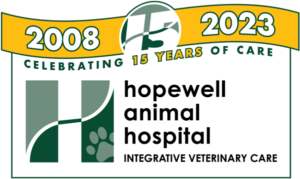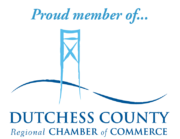Perhaps one of the most common procedures that we perform is dental work. Dental work can involve anything from a basic cleaning to advanced procedures such as root canal, vital pulpotomy, oral surgery and orthodontics. We understand that dental care can be expensive and we are often asked why the costs are what they are. We want you to fully understand our pricing structure and we also would like to take the opportunity to inform you what makes our service different than other practices.
It all starts in the examination room, once we diagnose dental disease we will try to evaluate how severe the condition is, unfortunately this is not always possible without sedation. We have developed 3 tiers for our pricing structure –
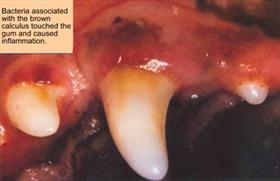
Grade 1 routine care and cleaning with no dental extractions, endodontics, or orthodontics expected.

Grade 2 Significant disease with endodontics or extractions expected.
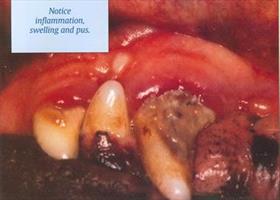

Grade 3 Very advanced disease that may require multiple extractions, and advanced procedures such as vital pulpotomy or tooth shaping.
In most cases we are pretty close, however Grade 1 disease can quickly turn into Grade 2 disease after dental radiographs are taken as often disease processes under the gums are not able to be identified without radiographs and a through examination.
Typically we require current laboratory work to evaluate liver, kidney, blood count, etc prior to anesthesia, this allows us to make changes to our anesthetic protocol if needed, in many cases we have found other conditions that would preclude us from performing anesthesia. This laboratory work can be done prior to the dental (which is usually less expensive) or the day of the procedure.
What to expect when your pet arrives at the office
Prior to any anesthesia we will inform you that you should not offer any food after midnight. Water is okay. When you come in, a receptionist will greet you and have you go into an examination room where the technician will take your pet’s vital signs, ask you about medications that your pet is taking, please remember to tell us about any supplements, vitamins, herbs etc. The technician will go over the estimate with you and explain each item. We typically try to email the estimate the day prior to the procedure so that you will have time to look it over prior to arrival. It is very important that you provide a contact number where you can be reached during the day, often times we have to make adjustments during the procedure and are unable to perform procedures without your consent if there is a significant deviation from the original plan.
Your pet will then be taken into the hospital and have a identification collar placed and placed in a quiet padded cage to wait until the procedure time. When it is time for the procedure we will give your pet a complete physical examination to be sure nothing has changed since the last visit. Your pet will then be given a pre-medication, this typically is composed of an opiate and a sedative, these medications “take the edge off” and provide pain control during the dental work. It takes about 15 minutes for this medication to take effect.
After the pre-medication takes effect we will place and intravenous catheter and start fluid therapy. We then will give your pet a combination of medications that will allow us to place an endotracheal tube for gas anesthesia. There are places that do not use anesthesia or advertise anesthesia free- the problem with this is you can not control the airway and water can get into the lungs and set up a pneumonia. The American Veterinary Dental College advises against this procedure.

Electronic Monitoring
After intubation your pet will be fitted with multiple monitors, these will track blood pressure, heart rate, oxygen saturation and temperature, we will also monitor plethismograph variability index to allow us to monitor pressure and hydration levels. We maintain your pet’s temperature with the help of heated water blankets, intravenous fluid warmers and hot air blankets. While your pet is under anesthesia we will place a lubricant in their eyes to prevent ulcers from forming from not being able to blink. We will also clip your pet’s nails. All of this monitoring is performed by a licensed veterinary technician dedicated to monitoring only your pet. All vital signs are recorded in 5-10minute increments. We maintain a full supply of medications to adjust your pet’s blood pressure should that be needed.
Each pet will have before and after photographs taken so that you can see the changes, these photos are placed on a chart that records any procedures done to each tooth, a copy of this is provided to you as part of our discharge instructions.
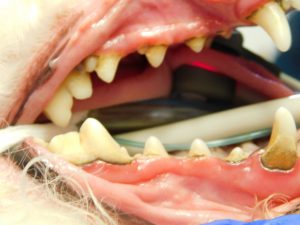
Before photo
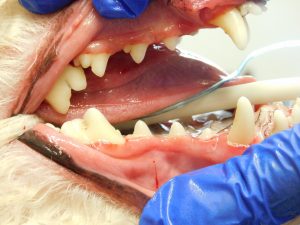
After photo
Before any work is performed a through oral exam is performed to look for cancers, changes to tonsils, and gum diseases.
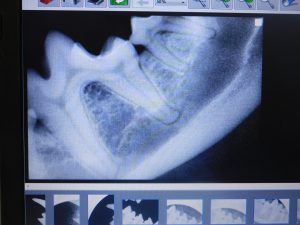 The first step of a professional cleaning/treatment involves dental radiographs. Each tooth is x-rayed to evaluate structure, bone loss, and evaluate the roots. While the radiographs are being evaluated by the doctor the technician is cleaning all of the teeth on all surfaces. For this procedure we use an ultrasonic scaler and hand scalers. We will then examine each tooth for dental pockets. These pockets can indicate bone loss or loss of attachment of the tooth to the surrounding gum. Deep pockets must be cleaned and in some cases we will place a long acting antibiotic into the space.
The first step of a professional cleaning/treatment involves dental radiographs. Each tooth is x-rayed to evaluate structure, bone loss, and evaluate the roots. While the radiographs are being evaluated by the doctor the technician is cleaning all of the teeth on all surfaces. For this procedure we use an ultrasonic scaler and hand scalers. We will then examine each tooth for dental pockets. These pockets can indicate bone loss or loss of attachment of the tooth to the surrounding gum. Deep pockets must be cleaned and in some cases we will place a long acting antibiotic into the space.
If any work is done to a tooth we will also place a local anesthetic block to numb the nerves to the tooth, this will allow your pet to use less gas anesthesia and also provide pain relief after the procedure.
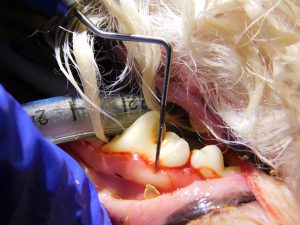
Measuring pocket depth
In some cases, we will remove teeth, in those cases we make use of the gingival flap technique which allows us to completely remove the tooth and associated roots. These flaps require suturing with very fine material, to facilitate this we use magnification glasses and powerful LED lights.
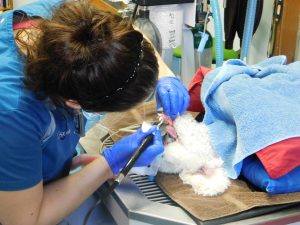
Dental cleaning
After the dental work is performed by the doctor a technician will then polish the teeth with an abrasive tooth paste and a low speed polishing handle. After this we will place either a long acting fluoride foam or a fluoride varnish to help protect the teeth from further decay.Your pet will then be observed while they recover from the anesthesia and may be given additional pain medications as needed. In order to provide our full attention to your pet we will only perform two procedures on a surgery day. Sometimes a complicated dental case can be under anesthesia for 3 hours and must be closely monitored and not rushed.
After all this is finished we will provide written take home instructions and a “goody bag” with dental chews and samples of toothpaste for at home care.
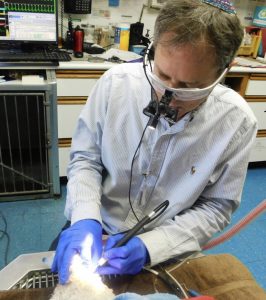
As you can well imagine, a dental procedure is not a simple surgery. All of the attention to detail is critical to ensure a safe and effective treatment, we treat each patient as we would treat our own.
We hope that this full description will help you to understand why dental care can be costly and is not something to shop for the lowest price available. If something sounds too cheap, there must be reasons why they can provide the lower price, maybe they are not using intravenous fluids or pain medications.
As alway, we hope if you have any questions you will contact us and we can explain more about our practice philosophy.
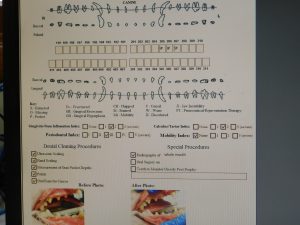
Dental Chart on discharge form

